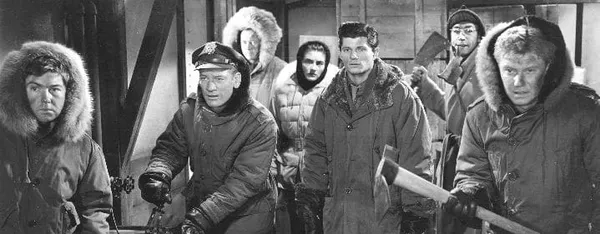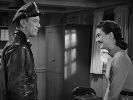Eye For Film >> Movies >> The Thing From Another World (1951) Film Review
The Thing From Another World
Reviewed by: Jennie Kermode

Long before John Carpenter reinvented it as The Thing, this Arctic chiller introduced the idea that invasion from space might begin on a remote part of the Earth, in territory where humans are themselves outsiders. Though there are hints of Communist infiltration terror in Charles Lederer's adaptation of the John W Campbell novella, it's closer in tone to the Quatermass story than to later Fifties films like Invasion Of The Bodysnatchers. There's a real sense of existential peril as our heroes, in their isolated base, realise that the fate of humanity may depend not just on their actions but on their ability to comprehend something utterly outside their experience.
Things begin simply enough. When something comes crashing out of sky near a scientific research station, a military crew is sent out to investigate. In an impressively constructed scene that still looks good today, they find - and accidentally destroy - a spacecraft trapped in the ice. Nearby, however, is what seems to be the frozen body of a pilot or passenger. Back at the research station, this is accidentally revived. It's from there that things being to go a bit pear shaped.

What makes this stand out from other science fiction films of the era is its ambiguous attitude to key themes of the period - the place of science, the value of conventionally macho behaviour and the role of women. Margaret Sheridan, though cast as a secretary rather than a doer or a thinker, is a strong presence in the film and has one scene with military hero Captain Hendry (Kenneth Tobey) that is shockingly sexual for the time. Although head scientist Dr Carrington (Robert Cornthwaite) is clearly not going to win with his argument that the world could benefit from communication with the alien, he does make himself useful and ultimately it takes a technological perspective to give our heroes a fighting chance. The alien, you see, is vegetable rather than animal, and as such, it's difficult to destroy by conventional means. In addition to this, its ability to produce fast-growing seedlings mean it has the potential to spread quickly and threaten the whole world.
In addition to this, the film ends with one of the most famous speeches in the genre, and one which has lost none of its import today. It may not have the populist gore of the Carpenter version - most of the horror is implied rather than taking place onscreen - but it has an underlying creepiness that rests on the very alienness of its antagonist. Offscreen most of the time, this creature seems unknowable, its precise motives obscure. Director Howard Hawks invites us to connect with the science-focused characters despite the more conventional moral appeal of Captain Hendry. He invites us to find terror in the smallness of our knowledge. Keep watching the skies.
Reviewed on: 23 Dec 2014
















